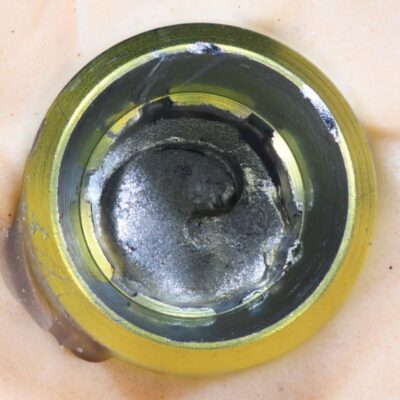May 2023
There has been much written on the use of ultrasonics in retrieving fractured screw fragments, which I didn’t think a lot about until May of 2023, as it has not been a part of my fractured screw retrieval algorithm. However, I had just recovered fractured abutment screws in two cases where the only reported previous recovery attempts had utilized a limited use of an ultrasonic scaler, yet the amount of implant damage was significant. The clinical findings did not correspond to my understanding as to what destruction an ultrasonic unit might be capable of creating.
So, I set up a simple trial to see if I could replicate this issue. To create the sample, a cast from a previous case with an Astra EV 4.2 analog in it was used. A new abutment screw was notched using a fine diamond disc in a position so the fracture zone would approximate the top of the implant threads. I then tried to recover the fragment by using a Dentsply cavitron at ¾ power for 2.5 minutes with water irrigation, mostly in a counterclockwise motion. The goal was to retrieve the screw fragment without implant damage. Unfortunately, there was no progress in retrieving the screw fragment, but what I discovered was surprising. The sample was photographed before and after the ultrasonic attempt and displayed below. In only 2.5 minutes, I was well on the way to totally destroying the internal aspect of this titamium analog. Furthermore, with the water spray the process was not controlled with any precision and the ability to hit just the screw fragment was basically impossible. After seeing this pattern of rounded destruction, I now had an understanding of the reason I am referred so many cases with locked screw fragments with this prior treatment history and with this unique rounded pattern of destruction. Therefore, I would highly recommend NOT using an untrasonic technique as a reliable, safe way to retrieve screw fragments. In my experience, a mobile screw fragment is effectively recovered without rotary or ultrasonic instruments. If the screw fragment is non-mobile, a concentric mobilization technique should be employed. Utilizing precision guidance to establish a concentric bore is a technique for safely guiding retrieval instruments. This protocol is a much safer method to avoid iatrogenic implant damage. In all cases, and for numerous reasons, microscope guidance is my #1 tool. CAM
Our team at Implant Mechanical Rescue, led by Dr. Mastrovich, is committed to providing quality dental care. We understand your concerns and work diligently to address your dental issues in a timely manner, so you can move forward with confidence.
Contact Dr. Mastrovich and the Mastrovich Dental Team for more information on Implant Identification or our Implant Mechanical Rescue services.








